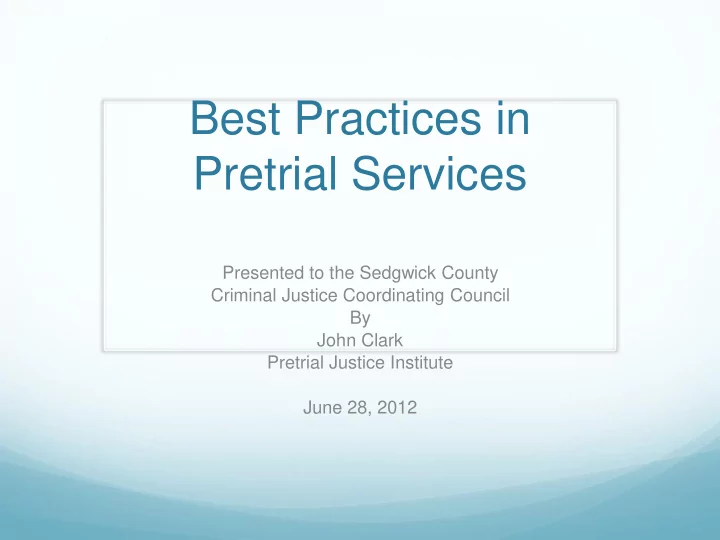

Best Practices in Pretrial Services Presented to the Sedgwick County Criminal Justice Coordinating Council By John Clark Pretrial Justice Institute June 28, 2012
Pretrial Justice Institute 2 Who we are Started in 1977 as the nation ’ s only non-profit agency dedicated to improving pretrial decision making. We help local justice systems establish fair and effective pretrial practices that eliminate inappropriate detention, optimize diversion from prosecution, and maintain community safety. We provide information, technical assistance and research results to criminal justice officials and community leaders at the federal, stateand local levels.
Pretrial Services Best Practices Interviews and investigates all defendants. Conducts risk assessment using validated tool. Recommends least restrictive conditions of release. Supervises conditions of release set by the court. Follows up on defendants in jail. Reminds defendants of their upcoming court dates.
Interviews and Investigations All defendants in custody. Should take place before the initial appearance. 2009 national survey of pretrial services programs: 26% have exclusions based on the charge, 22% if defendant on probation, parole, or pretrial release, 43% if a warrant from another jurisdiction, and 19% if warrant from same jurisdiction 69% conduct interviews and investigations before the initial appearance.
Pretrial Risk Assessment Should be objective and locally validated. Survey: 88% use an objective tool 42% say the tool was based on their own research, 35% say the tool was adapted from another jurisdiction, 23% say the tool was developed by local consensus on what should be included.
Recommendations Should make recommendations Should be for the least restrictive option necessary to reasonably assure community safety and court appearance. Survey: 88% of programs make recommendations.
Supervision Have the capacity to supervise conditions of release set by the court. Survey: 97% provide supervision services Supervision options include: Reporting in: 90% Drug testing: 88% Alcohol testing: 88% Referral to substance abuse treatment: 92% Referral to mental health services: 85% Home confinement/EM: 60% Restrictive movement/GPS: 44%
Bond Reviews Should conduct follow ups on defendants who remain in custody. Survey: 39% in all cases 16% in selected cases
Court Date Reminders Should remind defendants of their upcoming court dates. Survey: 35% call, 21% send letters
Focus on Risk Assessment What it can do – it is an actuarial tool that groups defendants into categories showing their probabilities of refraining from new criminal activity and making all court appearances by looking at certain characteristics. What it cannot do – it cannot predict which individual defendant will commit a new crime while on pretrial release or fail to appear in court.
Single Jurisdiction Pretrial Risk Assessment Studies Hennepin County, MN – 2006 New York City – 2007 Allegheny County, PA – 2007 Summit County, OH – 2008 Harris County, TX – 2009 Montgomery County, MD – 2009 Coconino County, AZ – 2010 Lee County, FL – 2011 Maricopa County, AZ - 2011 Wayne County, MI – 2012
Multi-Jurisdiction Pretrial Risk Assessment Studies Virginia – 2003, 2009 Federal - 2009 Ohio – 2009 Connecticut – 2009 Kentucky – 2010 Colorado – 2012 Florida – 2012 Michigan – in progress 12
Montgomery County, MD 15,000 new jail bookings a year; 1,200 jail beds Went from using a subjective risk assessment approach, where 20% of defendants were recommended for non-financial release, to a validated risk assessment instrument. The recommendation rate rose to 52%, with a corresponding rise in non-financial releases by the court – and no increases in rates of rearrest and FTA. Also reduced over-supervision of low risk defendants.
Outcomes From Pre-Existing RA Tool – Coconino County, AZ
Outcomes With Simulation of Research-Based RA Tool
Steps in Risk Assessment Collaborative stakeholder involvement/planning Bring in the analyst Determine sampling Data collection Data analysis Collaborative stakeholder involvement/implementation
Court Date Reminder Studies Nebraska – FTA rate was 12.6% for the comparison group and 8.3% for the study group. Multnomah County, OR – FTA rate for was 28% for the comparison group and 16% for the study group. Coconino County, AZ – FTA rate for the comparison group was 25.4% and 5.9% when caller spoke directly to the defendant and 15% when the caller left a message with an adult.
Best Practices in Pretrial Release Decision Making: Start With The Goals Honor the presumption ofrelease on least restrictive conditions. Secure defendants for trial. Protect community safety. 20
Defining “ Effectiveness ” in Achieving These Goals “ Effective bail decisions would foster the release of as many defendants as possible before trial, while maintaining suitably low failure to appear and rearrest rates. ” (John Goldkamp and Michael Gottfredson, Policy Guidelines for Bail: An Experiment in Court Reform .) 21
Effectiveness Formula All defendants - Those released who fail - Those not released __________________________________________ Effective releases 22
Ineffectiveness Defined “ Ineffective bail practices will needlessly hold releasable defendants in jail, and, thus, feed overcrowding and contribute higher than acceptable rates of pretrial flight and crime. ” (John Goldkamp and Michael Gottfredson, Policy Guidelines for Bail: An Experiment in Court Reform.) 23
Effectiveness questioned by high detention rate County A 100% 80% 67 Detained 60% Failure 40% Effective Release 11 20% 22 0% 1 24
Effectiveness questioned by high failure rate County B 100% 18 80% Detained 42 60% Failure 40% Effective Release 20% 40 0% 1 25
High effective release rate County C 100% 10 80% 25 Detained 60% Failure 40% Effective Release 65 20% 0% 1 26
Questions? John Clark Pretrial Justice Institute john@pretrial.org 202-638-3080, Ext. 301 202-841-3179 (cell)
Recommend
More recommend